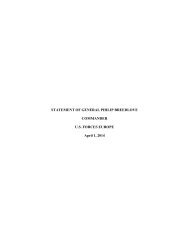FULLTEXT01
FULLTEXT01
FULLTEXT01
You also want an ePaper? Increase the reach of your titles
YUMPU automatically turns print PDFs into web optimized ePapers that Google loves.
TACTICAL THOUGHT<br />
2014 September 29 th<br />
Also, he points out different attitudes to the phenomenon, both from a political<br />
perspective as being dangerous with anarchistic influence potential, and from a military<br />
perspective as being doubtful of the results compared to the efforts. As a whole,<br />
Clausewitz mainly addresses the area of Irregular Warfare, primarily as one form of<br />
strategic defence. It is from the tactical view he outlines certain characteristics, such as<br />
flank attacks over large areas, harassing but not directed at the enemy strengths. As for<br />
the operational concept, he speaks of combining “loose formations”, “lantstorm” and<br />
“lantstorm supported with regular elements”. Combining these elements together in<br />
parallel for more offensive use is what Clausewitz writes, which links to operational art.<br />
Clausewitz describes a concept where tactics of what generally is understood as<br />
Guerrilla Warfare, support Regular Warfare combat, to be used when the right<br />
opportunities occur. Otherwise, a small scale attrition war in the enemy flanks and rear<br />
areas is the key characteristic. The arguably forceful force driver for war in general is<br />
the moral power, which can be found from the people rather than from regular military<br />
formations, according to Clausewitz.<br />
Result and conclusions<br />
The descriptions are both of an umbrella and explanatory character. The potential of<br />
explaining content covers aspects such as strategy, operational art and tactics. Fighting<br />
power factors are covered; physical, conceptual, and moral factors. The description<br />
covers characteristics and attitude aspects are included. Participating actors are<br />
described mostly with a focus on the aggressor perspective (people-at-arms). The<br />
description leans primarily on a military focus of the phenomena. The description is<br />
clear and substantial in its content and has potential understanding without<br />
complementary sub-explanations or definitions. Although from the Napoleonic times, a<br />
surprisingly comprehensive content is outlined, which expressed in more modern words<br />
could well be a contemporary definition of “Irregular Warfare”.<br />
Charles Callwell<br />
Callwell’s descriptions in his famous Small Wars are said merely to aim to give a sketch<br />
of the principles and practice of Small Wars regarding strategy and<br />
tactics………..against adversaries of whom modern works on military art seldom take<br />
account. 269 The first chapter gives the following description of the term Small Wars as;<br />
“somewhat difficult to define”….. “…practically can be said to include all campaigns<br />
other than those where the opposing side consists of regular troops” 270 Further on<br />
Callwell states; “It comprises the expeditions against savages and semi-civilised races<br />
by disciplined soldiers, it comprises campaigns undertaken to suppress rebellions and<br />
Guerrilla Warfare in all parts of the world where organized armies are struggling<br />
against opponents who will not meet them in the open field, and it thus obviously covers<br />
operations varying in their scope and in their conditions” 271<br />
269 Callwell, Small Wars: Their Principles and Practice (1996), p. 22.<br />
270 Ibid. p. 21.<br />
271 Ibid. p. 21.<br />
25





